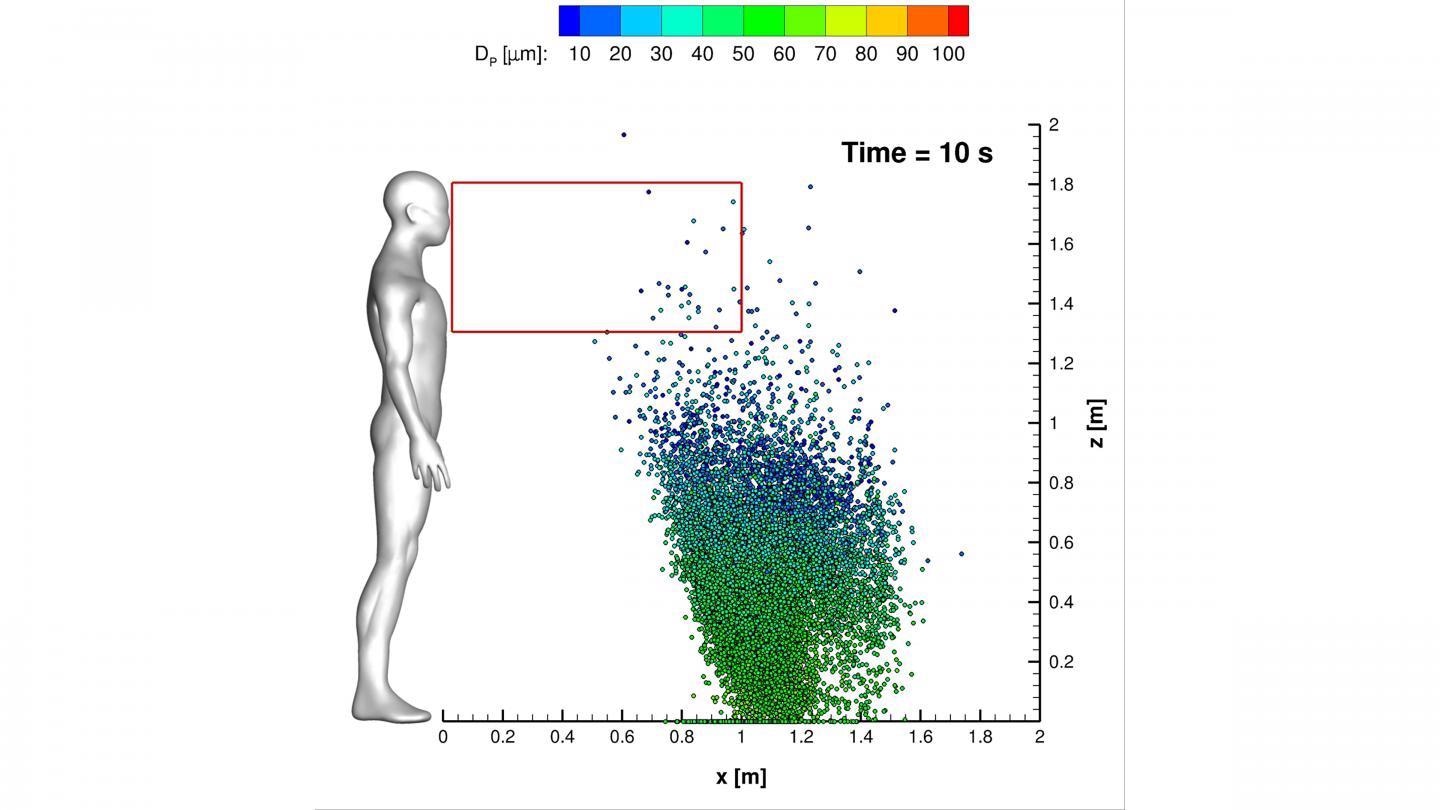Mar 10 2021
COVID-19 virus is primarily transmitted through airborne diffusion of saliva microdroplets. Hence, it is crucial to identify methods to destroy the virus in airborne microdroplets.
 In Physics of Fluids, Marche Polytechnic University researchers describe using a supercomputer to do numerical modeling of cough droplets irradiated by UV-C light: The red zone (from your chest down) is the area of highest risk, so while your face may only receive a few cough droplets, it is critical to wash your hands and keep them away from your face. Image Credit: V. D’Alessandro, M. Falone, L. Giammichele, and R. Ricci.
In Physics of Fluids, Marche Polytechnic University researchers describe using a supercomputer to do numerical modeling of cough droplets irradiated by UV-C light: The red zone (from your chest down) is the area of highest risk, so while your face may only receive a few cough droplets, it is critical to wash your hands and keep them away from your face. Image Credit: V. D’Alessandro, M. Falone, L. Giammichele, and R. Ricci.
Influenced by the extreme confusion that erupted at the start of the pandemic in relation to safe social behavior, social distances and mask-wearing, researchers from Marche Polytechnic University, who seem to be interested in saliva droplet diffusion, sought answers and ways to help.
In a paper published in the Physics of Fluids journal, from AIP Publishing, Valerio D’Alessandro and collaborators elaborate on the use of a supercomputer to perform numerical modeling of cough droplets irradiated by UV-C light. They also describe the investigation of the social distances needed to avoid the transmission of the virus.
The researchers identified the evolution of a saliva droplet cloud, considering the buoyancy, inertia and weight of each droplet and its aerodynamic interaction with the environment.
“We are interested in the possibility of deactivating virus particles via UV-C light,” noted D’Alessandro. “So, we explored the interaction of saliva droplets with an external source of UV-C radiation, a lamp.”
UV-C is a well-known germicidal technique since it interferes with the replication of the virus RNA.
UV-A and UV-B also kill germs and are present within the sun’s rays, but with these, it takes 15 to 20 minutes to kill a virus. The sun’s rays disinfect surfaces during the summer, which is one reason why transmission is reduced then, but it can’t be used for real-time disinfection. That’s why we decided to explore the effect of UV-C radiation on viruses.
Valerio D’Alessandro, Marche Polytechnic University
The study addresses crucial points that have not yet been understood completely. Firstly, they identified that a social distancing of 1 m (3.2 feet) is not completely safe to prevent virus transmission. This is specifically significant because this is the social distancing rule followed in Italy and its schools.
“While 1 meter of distance can suffice in a one-on-one situation, you can still get hit with cough droplets from the chest down,” stated D’Alessandro. “It’s necessary to avoid touching your eyes, nose, or mouth with your hands. We found 2 meters (6.5 feet) to be a much safer distance.”
D’Alessandro and his team reiterate that the largest droplets travel about 1 m. Across this distance, they found only smaller droplets, which transmit a decreased amount of the virus.
It’s important to emphasize that these results were obtained without any background wind, and if this is present, the distance is almost doubled. So we need to wear face masks, especially when in close proximity.
Valerio D’Alessandro, Marche Polytechnic University
The researchers also discovered that “it is possible to reduce the contamination risk by about 50% when irradiating saliva droplet clouds with UV-C radiation—without providing a dangerous dose to people,” added D’Alessandro. “This is critically important, because disinfection systems based on UV-C are not always acceptable. UV-C kills the virus, but higher doses for humans can be dangerous.”
Skin and eye tumors are the results of high exposures to UV-C light.
Our work helps correct the understanding of safe social distancing. Also, our computations can help to design new real-time disinfection devices based on UV-C that can reduce the risk of COVID-19 transmission and other viruses within particular situations, such as for supermarket cashiers or people in similar situations.
Valerio D’Alessandro, Marche Polytechnic University
Journal Reference:
D’Alessandro, V., et al. (2021) Eulerian-Lagrangian modeling of cough droplets irradiated by ultraviolet-C light in relation to SARS-CoV-2 transmission featured. Physics of Fluids. doi.org/10.1063/5.0039224.